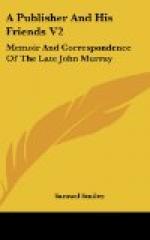Shortly before this first interview between Scott and Byron the news had arrived that Bonaparte had escaped from Elba, and landed at Cannes on March 1, 1815.
A few days before—indeed on the day the battle was fought—Blackwood gave great praise to the new number of the Quarterly, containing the contrast of Bonaparte and Wellington. It happened that Southey wrote the article in No. 25, on the “Life and Achievements of Lord Wellington,” in order to influence public opinion as much as possible, and to encourage the hearts of men throughout the country for the great contest about to take place in the Low Countries. About the same time Sir James Mackintosh had written an able and elaborate article for the Edinburgh, to show that the war ought to have been avoided, and that the consequences to England could only be unfortunate and inglorious. The number was actually printed, stitched, and ready for distribution in June; but it was thought better to wait a little, for fear of accidents, and especially for the purpose of using it instantly after the first reverse should occur, and thus to give it the force of prophecy. The Battle of Waterloo came like a thunderclap. The article was suppressed, and one on “Gall and his Craniology” substituted. “I think,” says Ticknor, “Southey said he had seen the repudiated article.” [Footnote: “Life, Letters, and Journals of George Ticknor “(2nd ed.), i. p. 41.]
Lord Byron did not write another “Ode on Napoleon.” He was altogether disappointed in his expectations. Nevertheless, he still, like Hazlitt, admired Napoleon, and hated Wellington. When he heard of the result of the Battle of Waterloo, and that Bonaparte was in full retreat upon Paris, he said, “I’m d——d sorry for it!”
Mr. Murray, about this time, began to adorn his dining-room with portraits of the distinguished men who met at his table. His portraits include those of Gifford, [Footnote: This portrait was not painted for Mr. Murray, but was purchased by him.] by Hoppner, R.A.; Byron and Southey, by Phillips; Scott and Washington Irving, by Stewart Newton; Croker, by Eddis, after Lawrence; Coleridge, Crabbe, Mrs. Somerville, Hallam, T. Moore, Lockhart, and others. In April 1815 we find Thomas Phillips, afterwards R.A., in communication with Mr. Murray, offering to paint for him a series of Kit-cat size at eighty guineas each, and in course of time his pictures, together with those of John Jackson, R.A., formed a most interesting gallery of the great literary men of the time, men and women of science, essayists, critics, Arctic voyagers, and discoverers in the regions of Central Africa.




